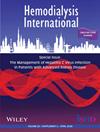Prevention of dialysis disequilibrium syndrome in children with advanced uremia with a structured hemodialysis protocol: A quality improvement initiative study
Abstract
Background
Dialysis disequilibrium syndrome (DDS) is a rare but significant concern in adult and pediatric patients undergoing dialysis initiation with advanced uremia or if done after an interval. It is imperative to gain insights into the epidemiological patterns, pathophysiological mechanisms, and preventive strategies aimed at averting the onset of this ailment.
Design
Prospective observational quality improvement initiative cohort study.
Setting and Participants
A prospective single-center study involving 50 pediatric patients under 18 years recently diagnosed with chronic kidney disease stage V with blood urea ≥200 mg/dL, admitted to our tertiary care center for dialysis initiation from January 2017 to October 2023.
Quality Improvement Plan
A standardized protocol was developed and followed for hemodialysis in pediatric patients with advanced uremia. This protocol included measures such as lower urea reduction ratios (targeted at 20%–30%) with shorter dialysis sessions and linear dialysate sodium profiling. Prophylactic administration of mannitol and 25% dextrose was also done to prevent the incidence of dialysis disequilibrium syndrome.
Measures
Incidence of dialysis disequilibrium syndrome and severe dialysis disequilibrium syndrome, mortality, urea reduction ratios (URRs), neurological outcome at discharge, and development of complications such as infection and hypotension. Long-term outcomes were assessed at the 1-year follow-up including adherence to dialysis, renal transplantation, death, and loss to follow-up.
Results
The median serum creatinine and urea levels at presentation were 7.93 and 224 mg/dL, respectively. A total of 20% of patients had neurological symptoms attributable to advanced uremia at the time of presentation. The incidence of dialysis disequilibrium syndrome was 4% (n = 2) with severe dialysis disequilibrium syndrome only 2% (n = 1). Overall mortality was 8% (n = 4) but none of the deaths were attributed to dialysis disequilibrium syndrome. The mean urea reduction ratios for the first, second, and third dialysis sessions were 23.45%, 34.56%, and 33.50%, respectively. The patients with dialysis disequilibrium syndrome were discharged with normal neurological status. Long-term outcomes showed 88% adherence to dialysis and 38% renal transplantation.
Limitations
This study is characterized by a single-center design, nonrandomized approach, and limited sample size.
Conclusions
Our structured protocol served as a framework for standardizing procedures contributing to low incidence rates of dialysis disequilibrium syndrome.

 求助内容:
求助内容: 应助结果提醒方式:
应助结果提醒方式:


